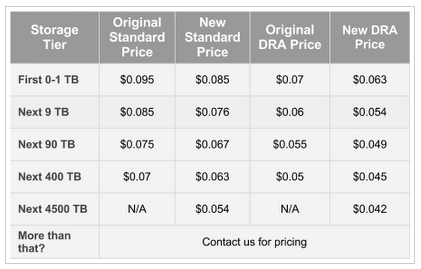 Just in time for the holidays, Google is slicing the prices of its Cloud Storage. Who doesn't love a little Cloud Storage under the holiday tree?[/caption] Just in time for the holidays, Google is slashing the prices of its Google Cloud Storage by another 10 percent. Combined with the 20 percent price-cut announced earlier this week, that’s a 30 percent markdown for the platform—a clear shot across Amazon’s bow, as the two tech giants compete for enterprise-cloud users. According to a Nov. 29 posting on the Official Google Enterprise Blog, that price reduction “applies to all Cloud Storage regions and the new DRA storage.” Durable Reduced Availability (DRA) storage was announced along with a handful of other products, including 36 new Compute Engine instances and European data-center support. Coming during the same week in which Amazon announced a bunch of new cloud features—including Redshift, a petabyte-scale data warehouse service, and a revamped AWS Data Pipeline—it seems clear that Google’s rapid succession of price cuts is designed to steal some thunder from one of its greatest opponents in the cloud space. Amazon’s AWS Blog suggests the Data Pipeline is a way for IT pros and developers to “automate the movement and processing of any amount of data using data-driven workflows and built-in dependency checking.” Nor is that all Amazon unveiled this week: ElastiCache, a scalable caching layer between application and database, now features Auto Discovery, for streamlining applications’ ability to adapt to the addition or deletion of nodes from cache clusters. Combined, the Amazon offerings are more than enough, potentially, for a rival to do something radical in response—like cut prices by a double-digit percentage. Amazon, Google, Microsoft and other large IT vendors have an increasing interest in the Platform-as-a-Service (PaaS) and Infrastructure-as-a-Service (IaaS) space, with all embracing pretty much the same selling point: with their respective platforms, each argues, companies can deploy applications and process datasets without needing to build out their own backend IT infrastructure. Image: Google
Just in time for the holidays, Google is slicing the prices of its Cloud Storage. Who doesn't love a little Cloud Storage under the holiday tree?[/caption] Just in time for the holidays, Google is slashing the prices of its Google Cloud Storage by another 10 percent. Combined with the 20 percent price-cut announced earlier this week, that’s a 30 percent markdown for the platform—a clear shot across Amazon’s bow, as the two tech giants compete for enterprise-cloud users. According to a Nov. 29 posting on the Official Google Enterprise Blog, that price reduction “applies to all Cloud Storage regions and the new DRA storage.” Durable Reduced Availability (DRA) storage was announced along with a handful of other products, including 36 new Compute Engine instances and European data-center support. Coming during the same week in which Amazon announced a bunch of new cloud features—including Redshift, a petabyte-scale data warehouse service, and a revamped AWS Data Pipeline—it seems clear that Google’s rapid succession of price cuts is designed to steal some thunder from one of its greatest opponents in the cloud space. Amazon’s AWS Blog suggests the Data Pipeline is a way for IT pros and developers to “automate the movement and processing of any amount of data using data-driven workflows and built-in dependency checking.” Nor is that all Amazon unveiled this week: ElastiCache, a scalable caching layer between application and database, now features Auto Discovery, for streamlining applications’ ability to adapt to the addition or deletion of nodes from cache clusters. Combined, the Amazon offerings are more than enough, potentially, for a rival to do something radical in response—like cut prices by a double-digit percentage. Amazon, Google, Microsoft and other large IT vendors have an increasing interest in the Platform-as-a-Service (PaaS) and Infrastructure-as-a-Service (IaaS) space, with all embracing pretty much the same selling point: with their respective platforms, each argues, companies can deploy applications and process datasets without needing to build out their own backend IT infrastructure. Image: Google Google Slashes Prices in Face of AWS Rollouts
[caption id="attachment_6203" align="aligncenter" width="421"]  Just in time for the holidays, Google is slicing the prices of its Cloud Storage. Who doesn't love a little Cloud Storage under the holiday tree?[/caption] Just in time for the holidays, Google is slashing the prices of its Google Cloud Storage by another 10 percent. Combined with the 20 percent price-cut announced earlier this week, that’s a 30 percent markdown for the platform—a clear shot across Amazon’s bow, as the two tech giants compete for enterprise-cloud users. According to a Nov. 29 posting on the Official Google Enterprise Blog, that price reduction “applies to all Cloud Storage regions and the new DRA storage.” Durable Reduced Availability (DRA) storage was announced along with a handful of other products, including 36 new Compute Engine instances and European data-center support. Coming during the same week in which Amazon announced a bunch of new cloud features—including Redshift, a petabyte-scale data warehouse service, and a revamped AWS Data Pipeline—it seems clear that Google’s rapid succession of price cuts is designed to steal some thunder from one of its greatest opponents in the cloud space. Amazon’s AWS Blog suggests the Data Pipeline is a way for IT pros and developers to “automate the movement and processing of any amount of data using data-driven workflows and built-in dependency checking.” Nor is that all Amazon unveiled this week: ElastiCache, a scalable caching layer between application and database, now features Auto Discovery, for streamlining applications’ ability to adapt to the addition or deletion of nodes from cache clusters. Combined, the Amazon offerings are more than enough, potentially, for a rival to do something radical in response—like cut prices by a double-digit percentage. Amazon, Google, Microsoft and other large IT vendors have an increasing interest in the Platform-as-a-Service (PaaS) and Infrastructure-as-a-Service (IaaS) space, with all embracing pretty much the same selling point: with their respective platforms, each argues, companies can deploy applications and process datasets without needing to build out their own backend IT infrastructure. Image: Google
Just in time for the holidays, Google is slicing the prices of its Cloud Storage. Who doesn't love a little Cloud Storage under the holiday tree?[/caption] Just in time for the holidays, Google is slashing the prices of its Google Cloud Storage by another 10 percent. Combined with the 20 percent price-cut announced earlier this week, that’s a 30 percent markdown for the platform—a clear shot across Amazon’s bow, as the two tech giants compete for enterprise-cloud users. According to a Nov. 29 posting on the Official Google Enterprise Blog, that price reduction “applies to all Cloud Storage regions and the new DRA storage.” Durable Reduced Availability (DRA) storage was announced along with a handful of other products, including 36 new Compute Engine instances and European data-center support. Coming during the same week in which Amazon announced a bunch of new cloud features—including Redshift, a petabyte-scale data warehouse service, and a revamped AWS Data Pipeline—it seems clear that Google’s rapid succession of price cuts is designed to steal some thunder from one of its greatest opponents in the cloud space. Amazon’s AWS Blog suggests the Data Pipeline is a way for IT pros and developers to “automate the movement and processing of any amount of data using data-driven workflows and built-in dependency checking.” Nor is that all Amazon unveiled this week: ElastiCache, a scalable caching layer between application and database, now features Auto Discovery, for streamlining applications’ ability to adapt to the addition or deletion of nodes from cache clusters. Combined, the Amazon offerings are more than enough, potentially, for a rival to do something radical in response—like cut prices by a double-digit percentage. Amazon, Google, Microsoft and other large IT vendors have an increasing interest in the Platform-as-a-Service (PaaS) and Infrastructure-as-a-Service (IaaS) space, with all embracing pretty much the same selling point: with their respective platforms, each argues, companies can deploy applications and process datasets without needing to build out their own backend IT infrastructure. Image: Google
 Just in time for the holidays, Google is slicing the prices of its Cloud Storage. Who doesn't love a little Cloud Storage under the holiday tree?[/caption] Just in time for the holidays, Google is slashing the prices of its Google Cloud Storage by another 10 percent. Combined with the 20 percent price-cut announced earlier this week, that’s a 30 percent markdown for the platform—a clear shot across Amazon’s bow, as the two tech giants compete for enterprise-cloud users. According to a Nov. 29 posting on the Official Google Enterprise Blog, that price reduction “applies to all Cloud Storage regions and the new DRA storage.” Durable Reduced Availability (DRA) storage was announced along with a handful of other products, including 36 new Compute Engine instances and European data-center support. Coming during the same week in which Amazon announced a bunch of new cloud features—including Redshift, a petabyte-scale data warehouse service, and a revamped AWS Data Pipeline—it seems clear that Google’s rapid succession of price cuts is designed to steal some thunder from one of its greatest opponents in the cloud space. Amazon’s AWS Blog suggests the Data Pipeline is a way for IT pros and developers to “automate the movement and processing of any amount of data using data-driven workflows and built-in dependency checking.” Nor is that all Amazon unveiled this week: ElastiCache, a scalable caching layer between application and database, now features Auto Discovery, for streamlining applications’ ability to adapt to the addition or deletion of nodes from cache clusters. Combined, the Amazon offerings are more than enough, potentially, for a rival to do something radical in response—like cut prices by a double-digit percentage. Amazon, Google, Microsoft and other large IT vendors have an increasing interest in the Platform-as-a-Service (PaaS) and Infrastructure-as-a-Service (IaaS) space, with all embracing pretty much the same selling point: with their respective platforms, each argues, companies can deploy applications and process datasets without needing to build out their own backend IT infrastructure. Image: Google
Just in time for the holidays, Google is slicing the prices of its Cloud Storage. Who doesn't love a little Cloud Storage under the holiday tree?[/caption] Just in time for the holidays, Google is slashing the prices of its Google Cloud Storage by another 10 percent. Combined with the 20 percent price-cut announced earlier this week, that’s a 30 percent markdown for the platform—a clear shot across Amazon’s bow, as the two tech giants compete for enterprise-cloud users. According to a Nov. 29 posting on the Official Google Enterprise Blog, that price reduction “applies to all Cloud Storage regions and the new DRA storage.” Durable Reduced Availability (DRA) storage was announced along with a handful of other products, including 36 new Compute Engine instances and European data-center support. Coming during the same week in which Amazon announced a bunch of new cloud features—including Redshift, a petabyte-scale data warehouse service, and a revamped AWS Data Pipeline—it seems clear that Google’s rapid succession of price cuts is designed to steal some thunder from one of its greatest opponents in the cloud space. Amazon’s AWS Blog suggests the Data Pipeline is a way for IT pros and developers to “automate the movement and processing of any amount of data using data-driven workflows and built-in dependency checking.” Nor is that all Amazon unveiled this week: ElastiCache, a scalable caching layer between application and database, now features Auto Discovery, for streamlining applications’ ability to adapt to the addition or deletion of nodes from cache clusters. Combined, the Amazon offerings are more than enough, potentially, for a rival to do something radical in response—like cut prices by a double-digit percentage. Amazon, Google, Microsoft and other large IT vendors have an increasing interest in the Platform-as-a-Service (PaaS) and Infrastructure-as-a-Service (IaaS) space, with all embracing pretty much the same selling point: with their respective platforms, each argues, companies can deploy applications and process datasets without needing to build out their own backend IT infrastructure. Image: Google 
